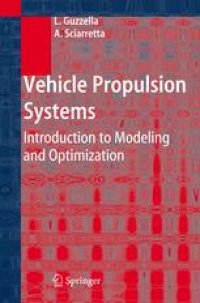
Ebook: Vehicle Propulsion Systems: Introduction to Modeling and Optimization
- Tags: Automotive and Aerospace Engineering Traffic, Engineering Thermodynamics Transport Phenomena, Control Engineering, Power Engineering
- Year: 2005
- Publisher: Springer Berlin Heidelberg
- Language: English
- pdf
Automobiles are responsible for a substantial part of the world's consumption of primary energy, mostly fossil liquid hydrocarbons. The reduction of the fuel consumption of these vehicles has become a top priority. Many ideas to reach that objective have been presented. In most cases these systems are more complex than the traditional approaches. For such complex systems a heuristic design approach fails. The only way to deal with this situation is to employ model-based methods. This text provides an introduction to the mathematical modeling and subsequent optimization of vehicle propulsion systems and their supervisory control algorithms.
Automobiles are responsible for a substantial part of the world's consumption of primary energy, mostly fossil liquid hydrocarbons. The reduction of the fuel consumption of these vehicles has become a top priority. Many ideas to reach that objective have been presented. In most cases these systems are more complex than the traditional approaches. For such complex systems a heuristic design approach fails. The only way to deal with this situation is to employ model-based methods. This text provides an introduction to the mathematical modeling and subsequent optimization of vehicle propulsion systems and their supervisory control algorithms.
Content:
Front Matter....Pages I-X
Introduction....Pages 1-11
Vehicle Energy and Fuel Consumption — Basic Concepts....Pages 13-40
IC-Engine-Based Propulsion Systems....Pages 41-56
Models of Electric and Hybrid-Electric Propulsion Systems....Pages 57-119
Models of Hybrid-Inertial and Hybrid-Hydraulic Propulsion Systems....Pages 121-146
Models of Fuel-Cell Propulsion Systems....Pages 147-187
Supervisory Control Algorithms....Pages 189-203
Appendix I — Case Studies....Pages 205-255
Appendix II — Optimal Control Theory....Pages 257-277
Back Matter....Pages 279-291
Automobiles are responsible for a substantial part of the world's consumption of primary energy, mostly fossil liquid hydrocarbons. The reduction of the fuel consumption of these vehicles has become a top priority. Many ideas to reach that objective have been presented. In most cases these systems are more complex than the traditional approaches. For such complex systems a heuristic design approach fails. The only way to deal with this situation is to employ model-based methods. This text provides an introduction to the mathematical modeling and subsequent optimization of vehicle propulsion systems and their supervisory control algorithms.
Content:
Front Matter....Pages I-X
Introduction....Pages 1-11
Vehicle Energy and Fuel Consumption — Basic Concepts....Pages 13-40
IC-Engine-Based Propulsion Systems....Pages 41-56
Models of Electric and Hybrid-Electric Propulsion Systems....Pages 57-119
Models of Hybrid-Inertial and Hybrid-Hydraulic Propulsion Systems....Pages 121-146
Models of Fuel-Cell Propulsion Systems....Pages 147-187
Supervisory Control Algorithms....Pages 189-203
Appendix I — Case Studies....Pages 205-255
Appendix II — Optimal Control Theory....Pages 257-277
Back Matter....Pages 279-291
....